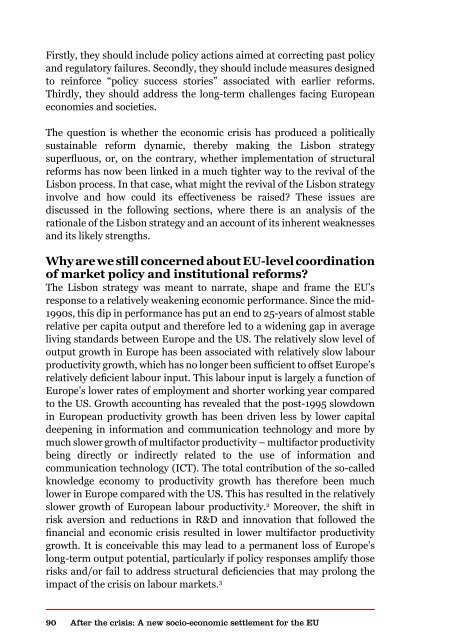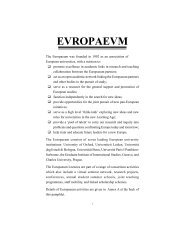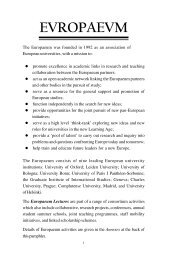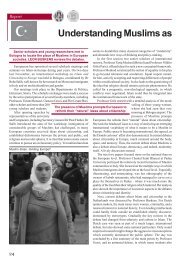Authors Iain Begg | Gabriel Glöckler | Anke Hassel ... - The Europaeum
Authors Iain Begg | Gabriel Glöckler | Anke Hassel ... - The Europaeum
Authors Iain Begg | Gabriel Glöckler | Anke Hassel ... - The Europaeum
You also want an ePaper? Increase the reach of your titles
YUMPU automatically turns print PDFs into web optimized ePapers that Google loves.
Firstly, they should include policy actions aimed at correcting past policy<br />
and regulatory failures. Secondly, they should include measures designed<br />
to reinforce “policy success stories” associated with earlier reforms.<br />
Thirdly, they should address the long-term challenges facing European<br />
economies and societies.<br />
<strong>The</strong> question is whether the economic crisis has produced a politically<br />
sustainable reform dynamic, thereby making the Lisbon strategy<br />
superfluous, or, on the contrary, whether implementation of structural<br />
reforms has now been linked in a much tighter way to the revival of the<br />
Lisbon process. In that case, what might the revival of the Lisbon strategy<br />
involve and how could its effectiveness be raised? <strong>The</strong>se issues are<br />
discussed in the following sections, where there is an analysis of the<br />
rationale of the Lisbon strategy and an account of its inherent weaknesses<br />
and its likely strengths.<br />
Why are we still concerned about EU-level coordination<br />
of market policy and institutional reforms?<br />
<strong>The</strong> Lisbon strategy was meant to narrate, shape and frame the EU’s<br />
response to a relatively weakening economic performance. Since the mid-<br />
1990s, this dip in performance has put an end to 25-years of almost stable<br />
relative per capita output and therefore led to a widening gap in average<br />
living standards between Europe and the US. <strong>The</strong> relatively slow level of<br />
output growth in Europe has been associated with relatively slow labour<br />
productivity growth, which has no longer been sufficient to offset Europe’s<br />
relatively deficient labour input. This labour input is largely a function of<br />
Europe’s lower rates of employment and shorter working year compared<br />
to the US. Growth accounting has revealed that the post-1995 slowdown<br />
in European productivity growth has been driven less by lower capital<br />
deepening in information and communication technology and more by<br />
much slower growth of multifactor productivity – multifactor productivity<br />
being directly or indirectly related to the use of information and<br />
communication technology (ICT). <strong>The</strong> total contribution of the so-called<br />
knowledge economy to productivity growth has therefore been much<br />
lower in Europe compared with the US. This has resulted in the relatively<br />
slower growth of European labour productivity. 2 Moreover, the shift in<br />
risk aversion and reductions in R&D and innovation that followed the<br />
financial and economic crisis resulted in lower multifactor productivity<br />
growth. It is conceivable this may lead to a permanent loss of Europe’s<br />
long-term output potential, particularly if policy responses amplify those<br />
risks and/or fail to address structural deficiencies that may prolong the<br />
impact of the crisis on labour markets. 3<br />
90<br />
After the crisis: A new socio-economic settlement for the EU

















